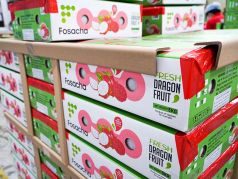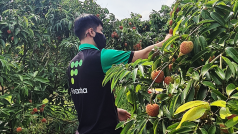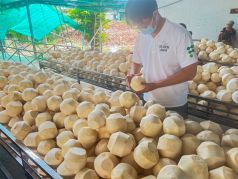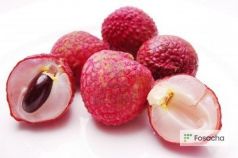Despite impressive growth in fruit exports, Vietnam still hasn’t built a national fruit brand that carries real recognition in global markets. This absence continues to limit the country’s potential to elevate value-added exports, build consumer trust, and compete with regional peers.
Vietnamese Lychee export 2025
 18/04/2025 10:58
18/04/2025 10:58
As global appetite for tropical fruits grows, Vietnamese lychee stands out as a rising star. In 2025, Vietnam's lychee industry is making bold moves into new, high-value markets while strengthening its foothold in existing ones. This export momentum is driven by certified cultivation practices, traceability, and cold chain investments.
As global appetite for tropical fruits grows, Vietnamese lychee stands out as a rising star. In 2025, Vietnam's lychee industry is making bold moves into new, high-value markets while strengthening its foothold in existing ones. This export momentum is driven by certified cultivation practices, traceability, and cold chain investments.
Stronger Global Reach
Vietnamese lychee reached over 30 markets in 2024. In 2025, exporters are targeting broader distribution through compliance with international standards.

[Vietnamese lychee predicted to have a successful harvest]
Key Market Highlights:
EU: 53 tonnes exported in 2024. Demand grows for GlobalGAP and organic-certified fruit.
Japan: 45 tonnes. Traceability and cold treatment unlock premium retail access.
Australia: 42 tonnes. Focus on clean, attractive fruit for strict retail channels.
USA: 20 tonnes. Expansion driven by compliance with VHT and Irradiation treatment.
UAE: 21 tonnes. Strong interest from luxury retail and hotel sectors.
Canada: 16 tonnes. Consistency and organic certification are key.
Southeast Asia: 18 tonnes. Favorable proximity and trade agreements boost growth.
Export Standards and Supply Chain Readiness
Behind this export success lies a concerted effort to raise the bar on quality and compliance. Cultivation areas are now systematically zoned and coded for traceability. In total, over 17,000 hectares of lychee orchards are registered under officially coded growing zones.
These zones are divided based on target markets:
- Areas coded for export to China follow specific protocols for pest control and post-harvest treatment.
- Zones targeting high-standard markets such as the U.S., EU, and Japan adhere to GAP and organic production standards, enabling faster customs clearance and higher market value.
This transformation is further supported by investments in post-harvest technology. Exporters are equipping packhouses with modern grading, cleaning, and packaging lines. Cold storage and logistics solutions ensure freshness is preserved during transit, particularly crucial for sea and air shipments to distant markets
Harvest Outlook for 2025
Favorable weather signals a productive season, with over 95% of lychee trees flowering successfully.
Early-season: Starts mid-May to early-June
Main-season: Peaks mid-June to July
Out of 30,000 hectares of total cultivation, over 20,000 hectares are dedicated to the main crop. Improved farming techniques continue to raise fruit quality. Total production in 2025 is expected to reach around 55,000 tonnes, with 31,500 tonnes from early-season lychees and 23,500 tonnes from main-season crops. This marks a substantial increase in yield from previous years.
2025 Market Trends
- Premiumization: Global consumers are showing increased willingness to pay for high-quality, traceable produce. Exporters are responding by focusing on appearance, sweetness, and safe agricultural practices.
- Sustainability and Certification: Markets like the EU, Canada, and Japan favor produce certified under GlobalGAP, VietGAP, or organic standards. As of 2025, the number of certified growing areas continues to rise, enhancing market access and product reputation.
- Brand Development: Efforts are underway to build strong brand identities around lychee, including geographical indication labeling and regional storytelling. Branded lychee is more likely to secure premium shelf space in foreign supermarkets.
- Digital Traceability: Exporters are increasingly adopting QR-coded packaging, allowing end consumers to trace the product’s journey from orchard to shelf. This builds trust and supports compliance with retailer demands.
- Cold Chain Investment: Infrastructure developments in cold storage and refrigerated logistics are improving the consistency and reliability of exports, especially for longer-distance destinations.
Looking Ahead
Vietnamese lychee is no longer confined to seasonal or regional popularity. With global certification, improved infrastructure, and strategic targeting, it is becoming a regular feature in premium produce aisles worldwide.
FOSACHA
(Based on data and trends through April 2025)











 Share
Share
 Tweet
Tweet







